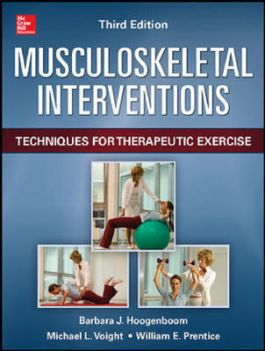EBOOK Musculoskeletal Interventions: Techniques for Therapeutic Exercise 3e
- Note: the eBook does not include access to Connect
- Access the eBook anytime, anywhere: online or offline
- Create notes, flashcards and make annotations while you study
- Full searchable content: quickly find the answers you are looking for
Chapter 1: Introduction to the Rehabilitation Process: The Guide to Physical Therapist Practice
Chapter 2: Clinical Decision Making in Rehabilitation, The Patient-Client Management Model
Chapter 3: Understanding and Managing the Healing Process through Rehabilitation
Chapter 4: The Neuromuscular Scanning Examination
Chapter 5: Clinical Reasoning: An Algorithm-based Approach to Musculoskeletal Rehabilitation
Part II: Treating Physiologic Impairments During Rehabilitation
Chapter 6: Impairment Due to Pain: Managing Pain During the Rehabilitation Process
Chapter 7: Impaired Posture and Function
Chapter 8: Impaired Muscle Performance: Regaining Muscular Strength and Endurance
Appendix A: ACSM Position Statements on Strength Training
Chapter 9: Impaired Endurance: Maintaining Aerobic Capacity and Endurance
Appendix B: ACSM Position Statements on Fitness Development
Chapter 10: Impaired Mobility: Restoring Range of Motion and Improving Flexibility
Chapter 11: Impaired Neuromuscular Control: Reactive Neuromuscular Training
Part III: The Tools of Rehabilitation
Chapter 12: Isokinetics in Rehabilitation
Chapter 13: Plyometric Exercise in Rehabilitation
Chapter 14: Open- versus Closed-Kinetic Chain Exercises in Rehabilitation
Chapter 15: Proprioceptive Neuromuscular Facilitation Techniques in Rehabilitation
Chapter 16: Joint Mobilization Techniques in Rehabilitation
Chapter 17: Strategies for Improving Balance
Chapter 18: Core Stabilization in Rehabilitation
Chapter 19: Aquatic Therapy in Rehabilitation
Chapter 20: Functional Movement Screening
Chapter 21: Functional Progressions and Functional Testing in Rehabilitation
Chapter 22: Orthotics in Rehabilitation
Chapter 23: Designing Exercise Programs for Home and Clinical Progressions
Chapter 24: Essentials of Functional Exercise: A Four-Step Clinical Model for Therapeutic Exercise Prescription
Part IV: Interventions Strategies for Specific Regions
Chapter 25: Rehab of the Shoulder
Chapter 26: Rehab of the Elbow
Chapter 27: Rehab of the Wrist, Hand and Fingers
Chapter 28: Rehab of the Groin, Hip, and Thigh
Chapter 29: Rehab of the Knee
Chapter 30: Rehab of the Lower Leg
Chapter 31: Rehab of the Ankle and Foot
Chapter 32: Rehab of Injuries to the Spine
Part V: Special Considerations for Specific Patient Populations
Chapter 33: Rehabilitation Considerations with the Geriatric Patient
Chapter 34: Considerations for the Pediatric Patient
Chapter 35: Considerations for treating Amputees
Chapter 36: Considerations for the Active Female
The definitive guide to designing and implementing evidence-based rehabilitation programs using therapeutic exercise -- updated in full color
A Doody's Core Title for 2015!
Musculoskeletal Interventions 3rd Edition is a comprehensive guide to the system considerations, design implementation, and progression of rehabilitation programs for musculoskeletal injuries and dysfunction. Encompassing many aspects of musculoskeletal rehabilitation with contributions from many renowned authors, it focuses on the practical application of theory in a clinical setting making it valuable to both students and experienced physical therapists. Musculoskeletal Interventions features an easy-to-follow body region and functional approach to intervention strategies and is logically divided into five sections:
Foundations of the Rehabilitation Process
Addresses the important considerations in designing a rehabilitation program for the patient with a musculoskeletal injury
Provides a guide-based overview of the rehabilitation process as well as an introduction to Clinical Reasoning and Algorithmic Thinking in rehabilitation
Treating Physiologic Impairments During Rehabilitation
Presents information on various physical impairments that may need to be addressed as part of the rehabilitation process
The Tools of Rehabilitation
Provides an overview of important rehabilitation tools and strategies
Delivers detailed coverage of how these interventions should be incorporated into a rehabilitation program to achieve the individualized treatment goals for patients with musculoskeletal pathologies
Intervention Strategies for Specific Injuries
Covers specific rehabilitation techniques and interventions applied to the treatment of a wide variety of regional musculoskeletal injuries dysfunctions and post-operative conditions
Special Consideration for Specific Patient Populations
Discusses treatment considerations for specific patient populations such as the geriatric patient pediatric patient and physically active female
This edition is enhanced by a new full-color presentation as well as the inclusion of valuable learning aids such as clinical pearls, protocol, grids, algorithms, learning objectives at the beginning of each chapter and end-of-chapter treatment guidelines and references.

